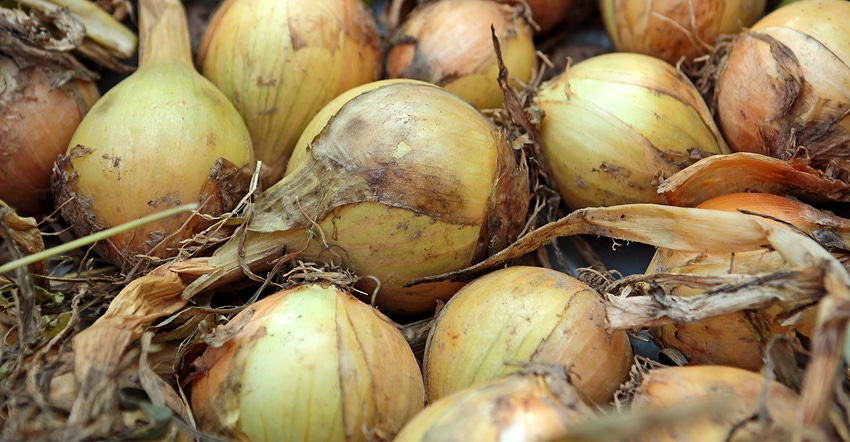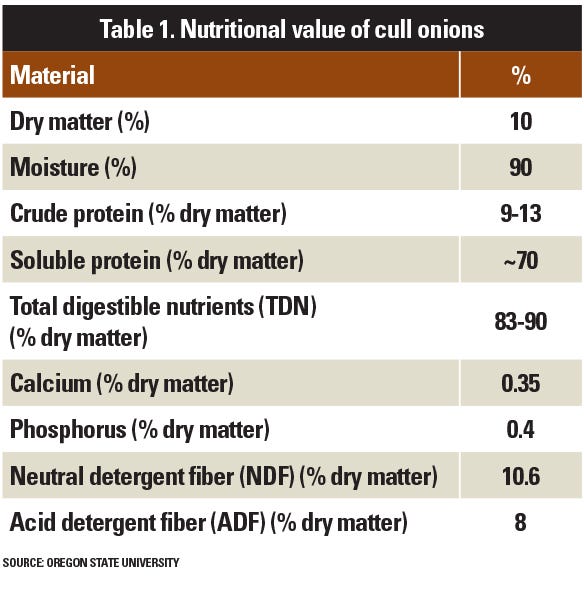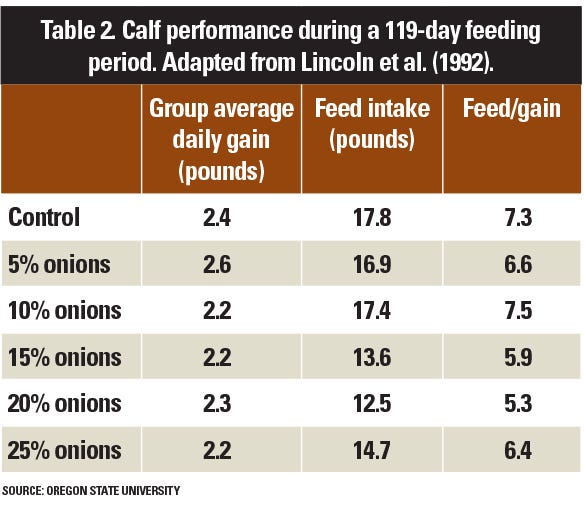February 12, 2019

There they sit. Onions in a pile. Onions that weren’t good enough to send to the store for human consumption. In Oregon, a domestic leader in storage onion production, disposing of cull onions has long been a problem. Sergio Arispe, Malheur County Extenson livestock specialist, recently published an article exploring the topic and offering a solution: Feed those culls to cattle.
Arispe notes that cull onions are a problem because they can be a host to the onion maggot fly, which can cause losses. He explored the concept of turning these onions into cattle feed, including a look at nutritional value and some dietary issues cattle producers should consider.
According to Arispe, cull onions have a nutritional value comparable to barley when compared on a dry matter basis. The challenge is that cull onions are about 90% moisture. Crude protein ranges from 9% to 13% on a dry matter basis, with 70% identified as soluble protein. And, he adds, cull onions are highly digestible.
With low fiber and lignin content, cull onions have a high total digestible nutrient content ranging from 83% to 90%. But there are challenges in feeding culls to cattle.

Problem feed
“Beef producers near onion-producing regions in Oregon have experienced setbacks feeding cull onions in beef cattle diets,” Arispe writes. “One problem is that the cull onions can induce onion poisoning, also called beef toxicosis.”
Cattle like cull onions, and they can get acute and potentially deadly disease if there’s too much in the diet. Arispe recalls a cattle producer who hauled just over a ton of cull onions into a pasture with 85 calves and yearlings that previously had had access to low-quality silage.
Within five days, signs of beef toxicosis turned up in the calves. The problem hit 22 calves and caused one fatality. Signs of the disease include lack of appetite, staggering, yellow-colored eyes and increased heart rate. If the signs appear, restrict cattle access to onions. A diet too high in cull onions can lead to hemolytic anemia and death.
The disease is caused by compounds common to the allium family of crops – garlic, shallots and onions. To get scientific, Arispe notes that the compounds have been identified as n-propyl-disulfide along with two rare amino acids – S-meth- and S-prop(en)ylcystein sulfoxide (SMCO). Microbes in the cattle rumen turn SMCO from the diet into the intermediary, thiosulfonate. This is then converted into either dipropyl disulfides and/or dipropenyl disulfides. These disulfides, along with n-propyl- disulfide, disrupt the normal oxygen-binding capacity of hemoglobin in red blood cells; this eventually leads to anoxia.
Those disulfide compounds also cause other blood-related issues that, in the past, have led to recommendations to avoid feeding cull onions to beef cattle. But Arispe notes that the idea has been re-evaluated.
Cull onions in the diet
If cull onions are available to add to the ration, Arispe offers some insight on the right approach. First thing to consider is that onions are 90% water, so consider calculating whether the cost for 10% dry matter is feasible for your operation. “Another limitation is how much cull onion to feed without compromising the growth and production of the herd,” he says.
He pointed to a 119-day feeding study that showed the impact of boosting onion percentages in a ration of 36 calves weighting 529 pounds each. In that research, where cattle were fed barley, corn silage and alfalfa, they also got nearly 25% cull onions on a dry matter basis. Researchers reported impacts on average daily gain, feed intake and feed-to-gain ratio. None of the animals in the study acquired clinical anemia. Arispe says that showed that this percentage of onion in the ration is safe to feed.

If you decide that cull onions are viable for your ration, he offered these tips:
• Gradually increase cull onions in the diet to allow rumen microbes to adapt to the addition.
• Do not provide cull onions as the sole feedstock
• Be aware of the clinical signs of beef toxicosis, and remove cull onions from the diet if symptoms appear.
• Chop and blend cull onions when feeding as an ingredient to prevent cattle from sorting.
Arispe concludes that cattle producers are identifying and acquiring a range of alternative feedstuffs to remain competitive. “Cull onions are an option that some beef cattle producers in Oregon have utilized for years and can continue to utilize to remain as economically viable operations,” he says.
Source: Oregon State University. The source is solely responsible for the information provided and is wholly owned by the source. Informa Business Media and all its subsidiaries are not responsible for any of the content contained in this information asset.
You May Also Like




